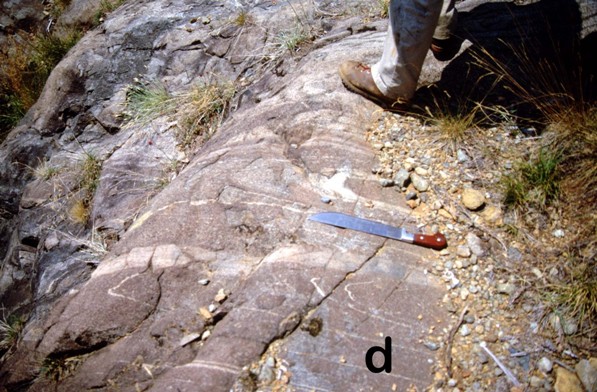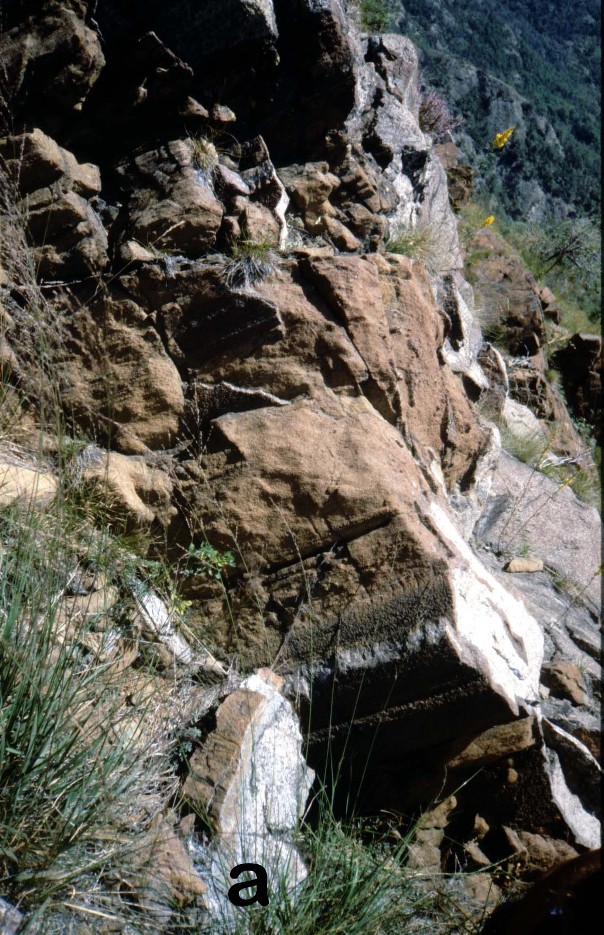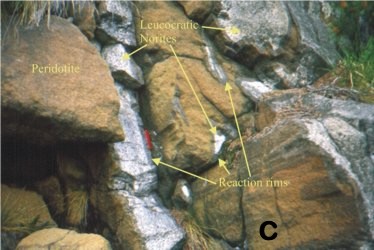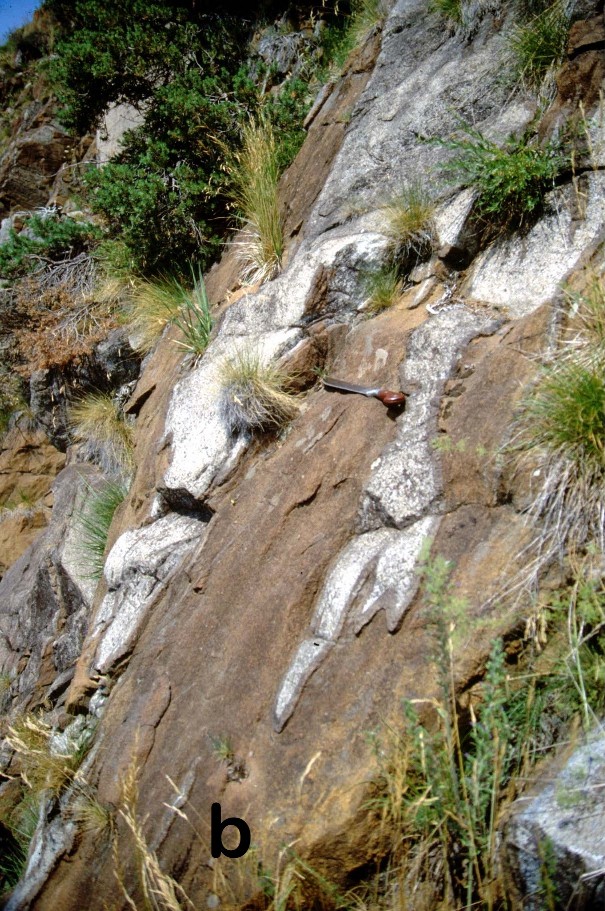Paragneiss septa
Numerous layers of granulitic paragneisses, termed septa, comprising metapelites, wackes and minor calc-silicates are found within the Mafic Complex . These layers are characterized by an extreme aspect ratio and some may be followed along strike for kilometers although they are only a few meters thick. Compared to the amphibolite-facies roof rocks, they are richer in garnet and extremely depleted in micas. Feldspars are generally antiperthitic and sillimanite forms discrete crystals, as opposite to fibrolite at the roof of the complex. Measured density of these rocks range from 2.9 to 3.4 gr/cm3, while roof rocks are within 2.7 to 2.9. The increase in density of the septa correlates with decreasing SiO2 and Rb abundance and increasing Al2O3 and FeO abundance, consistent with decrease of micas and increase of garnet in the restite as a result of larger extraction of anatectic granitic melt from the septa than from the roof rocks. Both measured densities of gabbro and computed densities the parental gabbroic melt at 5 Kb are close to 3gr/cm3, i.e. intermediate between the septa and roof rocks (Sinigoi et al., 1995).
The following mechanism has been proposed by Sinigoi et al., (1995) to explain the density, field and geochemical data. A basaltic sill ponded in the lower crust at its level of neutral buoyancy (Ryan, 1993). Upward migration of anatectic melt from the roof rocks left behind an increasingly dense restite until the density of the restite exceeded that of the underlying mafic magma. Local weakening due to the coalescence of the upward migrating anatectic melts may have facilitated detachment of the roof rocks. These denser roof rocks were incorporated into the complex as new additions of mafic melt ponded over them. A septum was formed and the new roof began to melt as a new cycle of intrusion, melting and density change began. After having been incorporated in the growing Mafic Complex, the melting septa were transposed together within the crystallizing gabbro glacier, so attaining their extreme aspect ratio and parallel fabric.
Figure 8. Geologic map of the Mafic Complex

Geologic map of the Mafic Complex in the southern Ivrea-Verbano Zone simplified from Quick et al. (2003).
Figure 8 shows the appearance that most septa are grouped near the transition between the lower Mafic Complex, dominated by mafic, granoblastic amphibole gabbro and the upper Mafic Complex, comprising gabbro, norite and diorite. Based on this distribution of the septa, Sinigoi et al. (1996) introduced the term “paragneiss bearing belt,” with the aim of defining a region where septa are more abundant. In fact, septa flair upward into higher levels of the Mafic Complex and their apparent concentration at deeper levels is a consequence of flow within the gabbro glacier. Thus, the paragneiss bearing belt should not be interpreted as a well defined layer with any temporal or stratigraphic significance. Furthermore, it should be noted that rare septa, too small to depict in Figure 8, are present in both the upper and lower Mafic Complex. In several cases, septa diverging upwards in the Mafic Complex connect with foliated granitoid bodies, suggesting segregation of anatectic melts from melting paragneiss septa during the growth of the gabbro glacier.
Figure 9. Paragneiss septum

Fault in paragneiss septum healed by charnockite. Fault curves into foliation plane to left of photo.
In the paragneiss bearing belt, septa are interleaved with mafic gabbros, a suite of rocks ranging from norite to charnockite and ultramafic cumulates. Among the latter, cumulus peridotites layers are up to 100 m thick East of the Balmuccia peridotite, in the area between Sesia and Mastallone Valleys (Intermediate Zone of the previous stratigraphic subdivision of Rivalenti et al. (1984) (Fig. 3) but become attenuated to few meters to the South. In the Sesia area, cumulus peridotite shows up to 2cm-thick reaction rims of pyroxene +spinel at the contact with gabbro (Figs. 11a,b,c). These rims developed under high-T subsolidus conditions, possibly still in presence of interstitial melt, as witnessed by synmagmatic deformation structure in proximal gabbros, (Fig. 11d) and were previously interpreted as cooling growths over slump structures (Rivalenti et al.1981). The cumulus peridotites in the Sesia area and associated gabbros are interleaved with paragneiss septa and most-likely crystallized in sills rather than in a huge magma chamber. Moreover, they show North-dipping lineations consistent with lineations of the gabbro (Figs. 11a,c). Collectively, these observations lead to the conclusion that these structures are better interpreted as sheath folds developed at very high temperature during stretching at the deep levels of the glacier. The reaction ol+plag = px+spinel is very sensitive to P and less sensitive to T (Presnall, 1976). The fact that these features developed beneath the core of the mafic body suggests they formed during the increase in pressure that affected these cumulates in axial position during stretching as they were transposed downward within the deforming gabbro glacier and buried beneath several kilometers of gabbro.
Figure 11. Sheath folds

Sheath folds with reaction rims between peridotite and gabbro, developed during stretching at high-T, increasing P.



